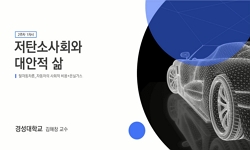This paper attempts to interpret the view of the editor Lee Ki by analysing Songwajapseol. Lee Ki was a member of Hansan Lee family. Lee Saek, Lee Gaerin, Lee Gaejon, and Lee Gae were the ancestors of Hansan Lee family, but they showed opposite att...
http://chineseinput.net/에서 pinyin(병음)방식으로 중국어를 변환할 수 있습니다.
변환된 중국어를 복사하여 사용하시면 됩니다.
- 中文 을 입력하시려면 zhongwen을 입력하시고 space를누르시면됩니다.
- 北京 을 입력하시려면 beijing을 입력하시고 space를 누르시면 됩니다.
https://www.riss.kr/link?id=A99761105
- 저자
- 발행기관
- 학술지명
- 권호사항
-
발행연도
2013
-
작성언어
Korean
-
주제어
송와잡설 ; 이기 ; 의식세계 ; 이색 ; 고려왕조 ; 세조 ; 왕위 찬탈 ; 이계린 ; 이계전 ; 이개 ; 한산 이씨 ; 당쟁 ; 임진왜란 ; 절망 ; 서사적 재현 ; 풍자 ; 이상적 인간형 ; 운명 ; 양극화 현상 ; 양변론 ; 대조 ; 대안 ; 태조 ; 원천석 ; 태종 ; 단종 ; 신숙주 ; 황희 ; 일화 ; 고려유신 ; 이상적 과거 ; 희망의 빛 ; representation ; Songwajapseol ; Lee Ki ; Hansan Lee family ; Lee Saek ; King Sejo ; usurpation of the crown ; power struggle ; Japanese Invasion ; despair ; problematic reality ; ideal type of person ; destiny ; contrast ; alternative way ; exclusion ; collapse ; Won Chonsuk ; King Taejong ; King Danjong ; dualism ; Whanghi ; anecdote ; ideal past ; alternative time
-
등재정보
KCI등재
-
자료형태
학술저널
-
수록면
141-176(36쪽)
-
KCI 피인용횟수
0
- 제공처
- 소장기관
-
0
상세조회 -
0
다운로드
부가정보
다국어 초록 (Multilingual Abstract)
Lee Ki was a member of Hansan Lee family. Lee Saek, Lee Gaerin, Lee Gaejon, and Lee Gae were the ancestors of Hansan Lee family, but they showed opposite attitudes in King Sejo’s usurpation of the crown. Lee Ki was agonized by those conflicting attitudes of the ancestors of Hansan Lee family. His internal conflict and search were reflected in Songwajapseol.
Lee Ki experienced power struggle between Parties and Japanese Invasion of Korea in 1592, which made him fall into deep despair. The feeling of hopelessness became the basis of the narrative representation of Songwajapseol. Lee Ki groped for four ways to overcome the despairing reality. First, heaccused and lampooned the problematic reality. Second, he searched for the ideal type of person. Third, he paid respect to the loyal subjects of the late Koryeo dynasty and the early Chosun dynasty. Fourth, he confirmed the way the destiny was realized and colored the world mysteriously.
Lee Ki captured the Chosun reality of the time by incorporating the narrative principle of contrast. But he looked for an alternative way to overcome the exclusion and collapse.
Lee ki emphasized and represented the paradoxical coexistence of Lee Saek and King Taejo, and Won Chonsuk and King Taejong. While Lee Ki criticized King Sejo’s usurpation of the crown and mourned the tragic end of King Danjon, he also excused Sin Sukjoo who turned against his friends and joined King Sejo’s rebellion. Lee Ki’s conflicting attitude was rooted in his hope to transcend the extreme dualism.
Lee Ki’s desire to transcend dualism was successfully accomplished in the representation of the Whanghi anecdotes. By stressing the fact that Whanghi was educated by the subjects of the fallen Koryeo dynasty, he emphasized Koryeo as an ideal past. This Ideal past became an alternative time which could overcome dualism and glorious past shedding light of hope for present despair.
This paper attempts to interpret the view of the editor Lee Ki by analysing Songwajapseol.
Lee Ki was a member of Hansan Lee family. Lee Saek, Lee Gaerin, Lee Gaejon, and Lee Gae were the ancestors of Hansan Lee family, but they showed opposite attitudes in King Sejo’s usurpation of the crown. Lee Ki was agonized by those conflicting attitudes of the ancestors of Hansan Lee family. His internal conflict and search were reflected in Songwajapseol.
Lee Ki experienced power struggle between Parties and Japanese Invasion of Korea in 1592, which made him fall into deep despair. The feeling of hopelessness became the basis of the narrative representation of Songwajapseol. Lee Ki groped for four ways to overcome the despairing reality. First, heaccused and lampooned the problematic reality. Second, he searched for the ideal type of person. Third, he paid respect to the loyal subjects of the late Koryeo dynasty and the early Chosun dynasty. Fourth, he confirmed the way the destiny was realized and colored the world mysteriously.
Lee Ki captured the Chosun reality of the time by incorporating the narrative principle of contrast. But he looked for an alternative way to overcome the exclusion and collapse.
Lee ki emphasized and represented the paradoxical coexistence of Lee Saek and King Taejo, and Won Chonsuk and King Taejong. While Lee Ki criticized King Sejo’s usurpation of the crown and mourned the tragic end of King Danjon, he also excused Sin Sukjoo who turned against his friends and joined King Sejo’s rebellion. Lee Ki’s conflicting attitude was rooted in his hope to transcend the extreme dualism.
Lee Ki’s desire to transcend dualism was successfully accomplished in the representation of the Whanghi anecdotes. By stressing the fact that Whanghi was educated by the subjects of the fallen Koryeo dynasty, he emphasized Koryeo as an ideal past. This Ideal past became an alternative time which could overcome dualism and glorious past shedding light of hope for present despair.
목차 (Table of Contents)
- 1. 서론
- 2. 한산 이씨 가문사와 이기의 세계관
- 3. 『송와잡설』의 서사적 재현과 이기의 의식지향
- 4. 대조의 서술원리와 양변론의 극복
- 5. 결론
- 1. 서론
- 2. 한산 이씨 가문사와 이기의 세계관
- 3. 『송와잡설』의 서사적 재현과 이기의 의식지향
- 4. 대조의 서술원리와 양변론의 극복
- 5. 결론
- 참고문헌
- [Abstract]
참고문헌 (Reference)
1 패림,
2 김려, "한고관외사" 한국정신문화연구원 2002
3 이강옥, "조선시대 일화의 일탈" 서울대 국문학연구회 1997
4 이강옥, "조선시대 일화 연구" 태학사 1997
5 강주진, "이조당쟁사연구" 서울대 출판부 1971
6 영신아카데미 한국학연구소, "야사총서의 개별적 연구" 1978
7 심노숭, "대동패림" 국학자료원 1991
8 이덕일, "당쟁으로 보는 조선역사" 석필 1997
9 이기, "간옹우묵" 한국학중앙연구원 출판부 2010
10 "韓國歷代人物集成" 民昌文化社 1980
1 패림,
2 김려, "한고관외사" 한국정신문화연구원 2002
3 이강옥, "조선시대 일화의 일탈" 서울대 국문학연구회 1997
4 이강옥, "조선시대 일화 연구" 태학사 1997
5 강주진, "이조당쟁사연구" 서울대 출판부 1971
6 영신아카데미 한국학연구소, "야사총서의 개별적 연구" 1978
7 심노숭, "대동패림" 국학자료원 1991
8 이덕일, "당쟁으로 보는 조선역사" 석필 1997
9 이기, "간옹우묵" 한국학중앙연구원 출판부 2010
10 "韓國歷代人物集成" 民昌文化社 1980
11 영신아카데미 한국학연구소, "野史叢書의 總體的 硏究" 1978
12 정만조, "16세기 사림파 관료의 붕당론" 국민대 한국학연구소 12 : 1989
동일학술지(권/호) 다른 논문
-
- 한국어문학회
- 김남경(Kim, Nam-gyeong)
- 2013
- KCI등재
-
- 한국어문학회
- 유경화(Liu, Qing-hua)
- 2013
- KCI등재
-
- 한국어문학회
- 이정복(Lee, Jeong-bok)
- 2013
- KCI등재
-
- 한국어문학회
- 허재영(Heo, Jae-young)
- 2013
- KCI등재
분석정보
인용정보 인용지수 설명보기
학술지 이력
| 연월일 | 이력구분 | 이력상세 | 등재구분 |
|---|---|---|---|
| 2026 | 평가예정 | 재인증평가 신청대상 (재인증) | |
| 2020-01-01 | 평가 | 등재학술지 유지 (재인증) |  |
| 2017-01-01 | 평가 | 등재학술지 유지 (계속평가) |  |
| 2013-01-01 | 평가 | 등재학술지 유지 (등재유지) |  |
| 2010-01-01 | 평가 | 등재학술지 유지 (등재유지) |  |
| 2008-01-01 | 평가 | 등재학술지 유지 (등재유지) |  |
| 2006-01-01 | 평가 | 등재학술지 유지 (등재유지) |  |
| 2004-01-01 | 평가 | 등재학술지 유지 (등재유지) |  |
| 2001-07-01 | 평가 | 등재학술지 선정 (등재후보2차) |  |
| 1999-01-01 | 평가 | 등재후보학술지 선정 (신규평가) |  |
학술지 인용정보
| 기준연도 | WOS-KCI 통합IF(2년) | KCIF(2년) | KCIF(3년) |
|---|---|---|---|
| 2016 | 0.56 | 0.56 | 0.56 |
| KCIF(4년) | KCIF(5년) | 중심성지수(3년) | 즉시성지수 |
| 0.54 | 0.53 | 0.99 | 0.1 |




 DBpia
DBpia






